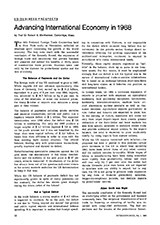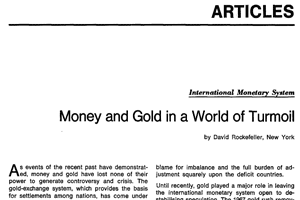Advancing International Economy in 1968
US Business Prospects
by Robert G. Wertheimer
The 54th National Foreign Trade Convention held in New York early in November, reflected an ebullient spirit concerning the growth of the world economy. The key note dealt with the successful conclusion of the Kennedy Round, the expansion of foreign trade and assurances that private business will preserve and extend the benefits of thirty years of constructive trade policies. Shadows were cast only by the clamour for protectionist quotas and the fate of sterling.
Volume 3, January 1968, No. 1
The Balance of Payments and the Dollar
The foreign trade of the US continued to grow in 1967. While exports did not advance spectacularly like those of Germany, they moved up to $ 31.2 billion, equivalent to a gain of 6 per cent over 1966; imports, too, advanced to $ 26.7 billion or by 4 per cent. In view of the weakness of some raw material prices, the rising $-value of imports also indicates a sharp gain in their volume.
The balance of payments including goods, services and financial transactions, private and public, run a liquidity balance deficit of $ 2 billion. This apparent deterioration over 1966 when the deficit was $ 1.6 billion, is misleading. Not only did 1967 produce a larger surplus of $ 4.5 billion (against $ 3.8 in 1966) on the goods account but it was not benefited by the large short-term capital inflows of $ 2.5 billion to banks from their affiliates in order to cope with the then existing tight money situation. The official balance, dealing only with government transactions, greatly improved and showed no deficit.
Notwithstanding speculative pressures against the US gold stock, the maintenance of full dollar convertibility and the stability of the gold price at $ 35 per ounce, remains reassured. A devaluation of the dollar has always been out of the question and recent events in the money markets underline the US determination to keep it that way.
While the US balance of payments deficit has not significantly grown in spite of many pressures—on the contrary, the dollar has shown great strength during the crisis—what of the future?
Not a Typical Deficit
In the trade balance, a strong surplus of $ 4-5 billion is expected to continue. As in the past, the deficit is not due to "living beyond our means" but private and public capital exports and international defense spending. It is important to realise that foreign spending in connection with Vietnam, is not responsible for the deficit which occurred long before this involvement. In the private sector, foreign direct investments reflecting the growing importance of the multinational enterprise, continued to expand in accordance with rising international needs.
Naturally, these capital exports registered as "deficits" in the balance, show up as gains in our long-term assets. For this reason, it must be emphasised strongly that our deficit is not the typical one in the nature of international trade-or-service indebtedness but is based on an exchange between short-term debts and long-term claims as it behoves our position as international banker.
In foreign trade, for 1968, a continued expansion of exports is projected with emphasis on agricultural machinery, food processing equipment, locomotives, machinery, telecommunications, machine tools, aircraft electronics, nuclear products as well as consumer durables. Agricultural exports particularly in rice, cotton and tobacco are expected to grow, too. In the earning of dollars, assistance will come not only from larger Export-Import Bank credits, greater utilisation of the Euro-Dollar and bond markets but also from specific measures to stimulate tourist trade and provide additional export credits. In the import balance, the total is expected to grow moderately chiefly by rising imports from mature nations.
While the US remains concerned with inflation—the proposed tax hike is geared to this problem—actual price increases in the US in every year including 1967, have been below those of any other country and the outlook remains favourable. While wages of labour in manufacturing have been rising somewhat more rapidly than productivity, labour unit costs still rose only by 7 per cent over the entire last decade. Domestic price rises hence, are not expected to interfere with our ability to export, but in any case, the US is not going to promote trade expansion by any form of financial gimmickery, subsidies, beggar-my-neighbour policies, nor restrain imports by protectionist devices.
Adam Smith was Right
The successful conclusion of the Kennedy Round had an electrifying effect on the government and business community here. The reciprocal liberalisation of world trade by lowering or removing of tariffs, was received with unequalled enthusiasm. The bad experience and the lessons of the protectionist Smoot-Hawley Act of 1930, have never been forgotten. Our economic health remains inseparable from that of our trading partners and the negotiated tariff reductions are a most vital step in making all other trade walls fall.
The success of the Round is due not only to the US but to the European Community and all other nations sharing world trade. The Community, above all, reduced tariffs on industrial imports by one-third and rate reductions will affect almost 90 per cent of its dutiable imports from the US. Even our agriculture, dealing with difficult situations abroad, is satisfied with the results while new opportunities were created for exports by efficient business here. Naturally, the US is fully prepared to participate in the rise of trade and to take its share of rising imports, particularly from the European Community which has much to offer. Of our total imports, the Common Market furnishes one-sixth, with the German share rising. While these exports to us comprise only a small share of total Common Market exports (7 per cent), this ratio is misleading because of its very large intracommon market trade. After July 1, 1968, the date of unification, the US share suddenly will soar and appear in the right light. Likewise, US exports to the Common Market accounting for one-tenth of our total, have been prosperous and growing.
The move toward freer trade is infectious and Adam Smith's maxime that "every prudent master of a family never attempts to make at home what it costs him more to make than to buy" is spreading worldwide. However, cutting tariffs is not enough as all other insidious restrictions are equally undesirable and, certainly, no new obstacles must be raised that could undo all gains already achieved.
No Chance for a Successful Protectionist Move
Demands for quotas, some urgent in nature and some motivated by "me too" attitudes, have spread from the steel, textile, chemical and oil industries to agriculture and a variety of other industrial products, metals and consumer goods such as shoes, the total now comprising one-half of our dutiable imports.
The Administration, challenged in its signatures to the Kennedy Round, promptly brought leading cabinet members to the Congressional Hearings where one member after the other testified as to the unbearable demands and ignorance of the protectionist supporters. Agricultural Secretary Freeman pointed out that one acre in every four of US farmland produces for exports. The Secretary of the Interior, Udall, asked for a reduction of existing oil quotas and Secretary of State Rusk enumerated leading export commodities from computers to farm tractors and poignantly asked which one of these industries should be sacrificed to insulate some economic sectors from import competition.
Ironically, the steel industry as leader of the quota move, deserves the least right to complain. Steel ignored modern technological progress until challenged by rising imports which now amount to one-tenth of total domestic steel output. Furthermore, steel contributed a major share to inflation in the fifties, when prices were increased in response to wage increases. However, due to price administering, the steel price rise was six times larger than needed to pay for higher wages. Finally, steel imports have now slumped sufficiently to take off much of the pressure for protection.
In a general review of all what has been brought for and against the institution of quotas, it can be said that fear of foreign retaliation will remain the strongest deterrent to such legislation.
There can be no doubt that many foreign products enter the US market in large amounts due to substantially cheaper prices and thus compete with domestic output. It also is true that steel imports during the last decade increased from 1 million ton to 11 million tons annually while corresponding exports declined to 2 million tons from 5 million. However, domestic adjustments thus needed only reflect the nature of competition in a growing world economy.
The burst of protectionist feelings showed up in demand for quotas because of existing tariff obligations; however, under GATT, also quota restrictions are outlawed. But there was other fuel for these demands, particularly the manipulation of special levies by the Common Market, its protectionist farm policies, and various other forms of non-tariff discrimination. Basically, though, the demand for quotas—which Senator Dirksen claims would not reduce imports and be generously expanded at the rate of US economic growth and without which "the country cannot survive, nor the economy on which it is based"—are politically motivated.
The final wisdom how to deal with any protectionist issue, was shown recently by a friend and neighbour of the US, President Díaz Ordaz of Mexico, when he counselled Congress "Before you act, it might be well to stop and consider just what effects your action would have on the rest of the world". We don't want to destroy the spirit of trade expansion, on the contrary, we want to build for further growth of world trade. The President's leadership in the rejection of quotas can be relied upon and his veto power will under all circumstances, be sufficient to prevent a relapse into protectionism.
The Outlook for Foreign Investment
In his sensational book on the "American Challenge", Servan-Schreiber gives a new interpretation to American investments in Europe and elsewhere. He explains that these ventures increasingly fed by locally raised financial resources, have brought into focus the American ability to organise and proceed with industrial and scientific strategy and creative imagination. This is the real basis of American success in foreign markets and not the emotionally-fed concept of a foreign "conspiracy to obtain control" of key industries. American management and enterprising remains at a premium-demand abroad in order to take advantage of the rapidly advancing US technology derived from huge amounts of research and development spending. The so-called technology gap between America and Europe should be reduced to prevent a growing imbalance for the sake of self-reliance and prestige of the latter though one does not have to resort to distortions in complaining about the situation. However, it is important to realise that we deal here predominantly with a management gap—more significant than the technological gap—due to the scientific management of business in America. Whatever the argument, the US must make its business activities abroad more acceptable to nationals of the countries where facilities are located in order to draw on a maximum of local support.
An internationalisation of corporations operating throughout the world—whether American or Dutch, German, British and so on—would smoothen the path for the international firm. An international company law administered by a supranational body should establish fairness standards for all such companies and equally insist on widely dispersed ownership.
Investment Plans for 1968
While many of these concepts have become guiding principles for the US multinational firm, practical investment plans for 1968 continue along well established lines. Direct capital exports will remain curtailed under the Voluntary Restraint Program. However, international growth of US firms will continue and foreign affiliates are expected to expand by another $ 9 billion. The bulk of needed financing will come from depreciation reserves, re-invested earnings and local borrowing. Net direct capital exports will moderately exceed $ 2 billion, a limitation increasingly resented by the business community in the fourth year of such restraint. Vast cash reserves for domestic and foreign spending that have been accumulated, cannot be put to full use yet.
The decline in earnings of foreign subsidiaries particularly in Europe, remains of little concern as long-range considerations continue to dominate management decisions of the international corporation. The growth of US investments in the Common Market will continue though increasingly financed by local resources.1 Germany as leading US trade partner, remains an attractive investment outlet. So far, total direct investments in the Federal Republic have reached $ 3 billion, with about three-fifths of these amounts invested in manuf.acturing and three-tenths in oil.
As to the future of the international corporation, growth is assured though its legal forms are still in flux. According to some investors, the concept of the Joint Venture, for example, is again and again singled out as the most desirable form of foreign growth patterns. For the benefit of the entire free world, the climate of international business should be improved and its existence legally anchored.
The Pound Devaluation
The American public—the business world, banks and officials that is—has been familiar with prospects of pound devaluation, for many years and thus was not caught by too much surprise except for the timing and the political price Mr Wilson may have to pay for it. The main concern of the experts here was with the response from the Common Market. Would they follow suit and, thus, force the dollar into a defense position? Even if they had followed the devaluation, the President, Congress and US monetary authorities would have upheld the price of gold at $ 35 per ounce and devised a system to uphold this rate.
Concerning the moderate pound devaluation, the main problem remains whether—implemented by other measures—it will solve the British balancing problem or will become the first leg only in a sequel of Latin American currency treatment.
What does the US expect as a result of the pound devaluation? First of all, Mr Wilson will have to succeed well internationally and domestically to maintain the Labour Party in office during the sixties. The devaluation as such has been accepted as necessary and overdue step and it is hoped that the pound can now be better protected as reserve currency and will continue to contribute to a proper financial climate of international stability and confidence.
The British market is considered to remain favourable for US exports. The moderate rise in the price of dollars is not expected to become a significant trade hindrance. On the contrary, successful adjustments within the British economy should enhance its ability to import. Dollar earnings are going to increase, too, not so much from larger exports of consumer goods to the US but from the earnings of travel dollars. American affiliates in England are expected to gain in balance, in terms of growing markets and rising profits.
Short-term capital flows from the US to the London money market, attracted by high interest rates, are under way but within the limits of the Voluntary Restraint Program already mentioned. After acceptance of the new pound, it is unlikely that the high money rates in London will continue. Even without this temporary measure, it should not be expected that the pound will be gradually eliminated as reserve currency. In addition to the dollar and the evolving resources provided by the Monetary Fund, the world depends on additional reserves to facilitate trade, and not only within the sterling area. If the members of the Common Market had overcome their financial nationalism and, backed by their large gold and foreign exchange reserves, established a common currency of their own some years ago, this now might rival the usefulness of the pound as reserve currency or even gradually replace it. Today, the individual currencies of the members of the Common Market do not command sufficient international attraction to be demanded as reserves.
Monetary Reform Plans
The expansion of world trade to $ 400 billion with annual growth rates of close to ten per cent requires a corresponding growth in the financial underpinning, so-called liquidity. Annual gold output cannot keep up with these growth rates while an increase in the price of gold, say doubling, would only be a palliative wrought with explosive financial and political dangers. The increase of the price of gold would not only be an inflationary move but also precipitate great uncertainties as to the economic future of many countries. It also would make the rich countries richer and not bring aid to needy nations. Furthermore, it would be inequitable as to US short-term dollar obligations for those countries holding on to them instead of gold.
The so-called international reserves add to international buying power and fulfil credit needs but they originate partly with balance of payments deficits of the reserve currency country. It is unlikely, therefore, that the amounts of reserve currencies available to the world will increase, at least in the near future. The dollar deficit is being reduced in compliance with the demands of our friends who wish an early disappearance of the dollar gap while the status of the pound as reserve currency has suffered. No other reserve currency is in the making, and, hence, the importance of the Monetary Fund as depository, guardian and creator of international resources to satisfy the needs of the financial community, has no equal.
Resource Position not Satisfactory
There can be no doubt that the dollar in its role as easily available means for financing international trade and investment, again will become more plentiful available, at least outside of the Common Market, at some future date. No absolute rules as to the proper proportions between US gold holdings and current US international liabilities exist. However, the present relationship should be considered quite "conservative". Nevertheless, the world's reserve structure needs a permanent addition of new types of assets in order to keep a proper ratio between available liquidity and the expansion of world trade. With total reserves of gold, dollars, pounds and Monetary Fund Drawing Rights amounting to $ 71 billion now and probably declining soon because of lesser pound use and smaller US deficits, the reserve position is not very satisfactory. Since 1947, international reserves have grown by only 2.7 per cent annually while imports, that is payments obligations, have expanded at annual rates of 8.4 per cent. It is, therefore, of utmost importance that the Monetary Fund is advancing a concept in order to bring relief to liquidity needs.
The addition to reserve assets is planned in the form of Special Drawing Rights.2 US Monetary authorities approve the plan to provide international credit or assets though their issuance will have to be limited to small, non-inflationary additions to international purchasing power. The US does not intend to use these drawing rights to finance deficits in its balance of payments but will recommend the use of these new privileges by countries with weaker currencies.
The Developing Nations
Assistance to the Developing Nations must be provided faster and on a larger scale. In spite of grants and loans given to needy countries—the US far in the lead with $ 125 billion—no dramatic improvements have been achieved. All developing nations urgently need capital imports but the bulk of foreign investments continues to go to the rich countries. Even the limited amounts made available, go for exploitation of natural resources rather than for raising productivity. True help can come only from investment in more equipment, agriculture, marketing and the development of skilled labour.
The path to progress remains rising investment not only in various forms of equipment but also management know-how, education and the elimination of the myth of foreign exploitation which has remained the most damaging obstacle carried over from colonial days. Recently, another area of assistance has been emphasised, namely the granting of special tariff advantages by industrialised nations to all developing countries. This concept of trade preferences designed to facilitate the exports of finished consumer goods by the poor countries to the rich, has become a kind of substitute for other goals more difficult to accomplish such as the under-writing of their agricultural and raw material exports by an international quantity-and-price-support program.
A new preoccupation with Latin America has taken place. Not only has the US a total investment of $ 10 billion in this area, but many changes have taken place to make this relationship a more effective one. Among them, the Alliance for Progress, the support of common markets in Latin America, the emphasis on joint ventures in operation and ownership and the rising reliance on local people for business leadership, must be mentioned. In this spirit, must we understand the US commitment to seek wider markets for Latin American goods. The declining share of imports from Latin America in the Common Market, because of the preference for imports from the Associated African nations, has created much pressure to provide special US preferences. For the time being, the US will not yield to demand for the granting of single area preferences though it favours the formation of a single common market with an effective integration of industries there.
East-West Trade
While the expansion of trade between Europe and Soviet-type economies is looked upon with sympathy (except for limitations due to Vietnam), no particular steps are being taken to expand US trade with these areas. Basically, there are very few types of commodities the US wishes to purchase from these countries, nor do they offer attractive pricing propositions. It is true that the US, on conceptual grounds, is seeking to improve commercial relations with the Soviet Union and Eastern Europe. However, for the duration of the Asian conflict, trade limitations related to various aspects of military and economic security make trade expansion unlikely. The Trade Convention, in its summary position, opposes long-term credits to all Communist countries and also wishes to exclude from trade all products involving technical information, advanced technology or know-how. However, the American business community regrets recent Congressional proposals aimed at contraction of trade in non-strategic commodities with Soviet-type countries and supports the motion that the President be given discretionary powers to grant them most-favoured-nation tariff treatment. Furthermore, all local ordinances designed to discourage retail sales of imported products from Eastern Europe, should be outlawed.




